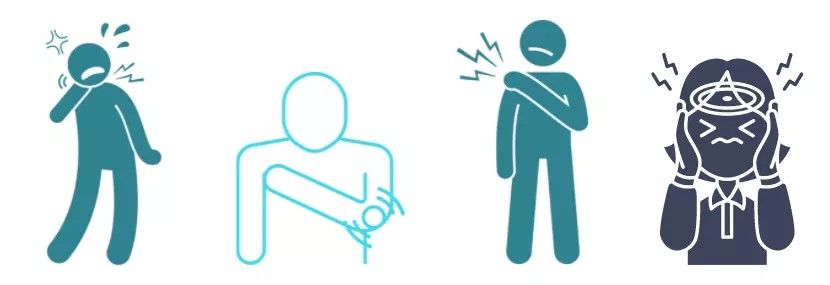
Headaches and body aches are among the most common health complaints experienced by people of all ages. These discomforts can range from mild and temporary to severe and chronic, significantly impacting daily life. Understanding the causes, types, and treatment options for headaches and body aches is essential for effective management and relief.
Understanding Headaches
Headaches are characterized by pain in the head or neck region. They can be classified into several types, including tension headaches, migraines, cluster headaches, and secondary headaches caused by underlying conditions.
-
Tension Headaches: These are the most common type of headache, often described as a constant pressure or tightness around the head. Stress, poor posture, and lack of sleep are common triggers.
-
Migraines: Migraines are more severe and often accompanied by nausea, vomiting, and sensitivity to light and sound. They can last for hours or even days and are sometimes preceded by an “aura,” which includes visual disturbances.
-
Cluster Headaches: These are extremely painful and occur in cyclical patterns or clusters. They are less common but can be debilitating.
-
Secondary Headaches: These are caused by underlying conditions such as sinus infections, head injuries, or medication overuse.
Understanding Body Aches
Body aches, or myalgia, refer to pain or discomfort in the muscles and joints. They can be localized or widespread and are often associated with fatigue, illness, or physical exertion.
-
Muscle Strain: Overuse or injury to muscles can lead to aches and pains. This is common after intense physical activity or poor ergonomics.
-
Infections: Viral infections like the flu or COVID-19 often cause widespread body aches as the immune system fights off the infection.
-
Chronic Conditions: Conditions like fibromyalgia, arthritis, and lupus can cause persistent body aches and require long-term management.
-
Lifestyle Factors: Poor posture, lack of exercise, and stress can contribute to muscle tension and discomfort.
Treatment Options for Headaches and Body Aches
The treatment for headaches and body aches depends on the underlying cause. Here are some common approaches:
-
Over-the-Counter Medications: Non-prescription pain relievers like ibuprofen, acetaminophen, and aspirin are often effective for mild to moderate pain. These medications reduce inflammation and alleviate discomfort.
-
Prescription Medications: For severe or chronic pain, doctors may prescribe stronger medications, such as triptans for migraines or muscle relaxants for body aches.
-
Lifestyle Modifications: Stress management, regular exercise, and proper hydration can help prevent headaches and body aches. Maintaining good posture and ergonomics is also crucial.
-
Alternative Therapies: Techniques like acupuncture, massage therapy, and chiropractic care can provide relief for some individuals.
-
Rest and Recovery: Ensuring adequate sleep and allowing the body to recover after physical activity can reduce the frequency and severity of aches.
-
Heat and Cold Therapy: Applying heat packs or cold compresses to affected areas can alleviate muscle tension and inflammation.
Noosanta 100mg: A Closer Look
Noosanta 100mg is a medication commonly prescribed for the treatment of moderate to severe pain, including headaches and body aches. It contains the active ingredient Tramadol, which is an opioid analgesic. Tramadol works by binding to opioid receptors in the brain and inhibiting the reuptake of serotonin and norepinephrine, thereby altering the perception of pain.
Uses of Noosanta 100mg
Noosanta 100mg is primarily used to manage pain that is not adequately controlled by other pain relievers. It is often prescribed for:
-
Chronic headaches or migraines
- Post-surgical pain
- Pain associated with injuries or musculoskeletal conditions
- Pain related to chronic conditions like arthritis
Dosage and Administration
The dosage of Noosanta 100mg should be determined by a healthcare professional based on the severity of the pain and the patient’s medical history. It is typically taken orally, with or without food. The medication should be used exactly as prescribed to avoid potential side effects or dependency.
Side Effects
- Like all medications, Noosanta 100mg may cause side effects, including:
-
Nausea or vomiting
-
Dizziness or drowsiness
-
Constipation
-
Dry mouth
-
Headache (in rare cases)
- Serious side effects, such as difficulty breathing or signs of an allergic reaction, require immediate medical attention.
Precautions
Noosanta 100mg should be used with caution in individuals with a history of substance abuse, liver or kidney disease, or respiratory conditions. It is not recommended for use during pregnancy or breastfeeding without consulting a doctor. Patients should avoid alcohol and other central nervous system depressants while taking this medication.
Addiction and Dependency
As an opioid, Tramadol has the potential for abuse and dependency. It is important to use Noosanta 100mg only as prescribed and to discuss any concerns about dependency with a healthcare provider.
Conclusion
Headaches and body aches are common ailments that can significantly impact quality of life. Understanding the causes and types of these pains is the first step toward effective management. Treatment options range from over-the-counter medications and lifestyle changes to prescription drugs like Noosanta 100mg. Noosanta 100mg, containing Tramadol, is a potent option for moderate to severe pain but should be used under medical supervision due to its potential side effects and risk of dependency.